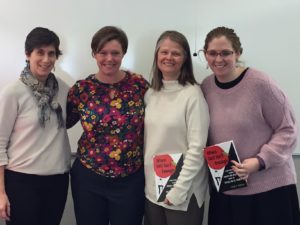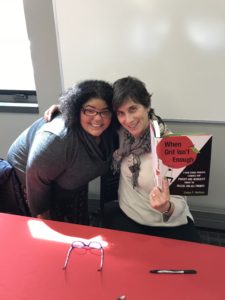
From Left: Me; Kelly Brotzman, Executive Director of the Martin Richard Institute for Social Justice; Sabrina Gentlewarrior, Vice President, Student Success and Diversity; Meredith Deacon, Coordinator of Student Success Interventions, Student Success and Diversity
I wrote When Grit Isn’t Enough for lots of reasons. As I got into the writing and research, I began to realize that one of the main reasons I was writing was to help influence the way college financial aid and student success offices do their business and work with their clients – the students. I know that may sound like a lot of hubris since my professional experience is not primarily in higher education. I’ve been in PreK-12 education for almost forty years. I’ve taught at Harvard’s Graduate School of Education, but that doesn’t count for “knowing higher ed.” I also worked for two years at Boston University, but again, that’s a drop in the bucket in terms of experience.
However, a few weeks ago, I had the chance to give a talk at Bridgewater State University. My host, Dr. Kelly Brotzman of the Martin Richard Institute for Social Justice, not only invited students to my talk, but also many University employees from the financial aid and student service offices. After my remarks, and as we got into the question and answer period, one of the employees asked the Bridgewater students in the audience how they would like to be informed about financial aid deadlines.
It was a wonderful moment. And one that made the trip truly worth it! This is the kind of question and discussion I hoped my book would ignite.
The students were quick to respond. They relayed that they receive numerous emails and see posters all around campus reminding them of deadlines. What would be more beneficial, however, is to receive an automated text on their phone (like they do in a snow emergency) reminding them about the upcoming financial aid deadlines. The staff person seemed to think this was a novel idea, but acknowledged how helpful something like that could be. I am hopeful that this practice will be implemented.
Another student offered her sense of racial isolation on campus: “I’m a campus leader,” she began, “and I know I mostly hang out with people who look like me.” She pointed to her curly thick hair and her light tan complexion. “And there are very few that look like me on campus. But when we did a survey about whether students hang out with people who look different from them or are part of a different racial and ethnic group, most said, ‘frequently.’ I have been really confused by that word. Because, as I said, I mostly hang out with people who are nonwhite. What does frequently mean, really, to people? Once a month? I think we have to change our language and the questions we ask if we want to better understand racial isolation. I love this school, but I rarely see people of different backgrounds hanging out together.”
Other students of color in the room nodded their heads. Some of the white students did too. I wasn’t sure what the adults were thinking or feeling about this comment. Could this be a turning point for them to realize the work ahead of them?
I wanted to share Dr. Brotzman’s introductory words to my talk as I think they capture the experiences of these students, and others, and suggest the work that we must do as a country to eradicate feelings of racial isolation on college campuses, and the structures we must develop to ensure that all students understand their responsibilities when it comes to things like financial aid.
Dr. Brotzman said:
“When we thought about the issues we wanted to highlight this year, we decided to focus on the American educational system. One of the main reasons we chose this focus is that the rhetoric of opportunity and upward mobility which so often permeates our conversations about education in this country obscures some stubborn facts, such as: (1) Educational outcomes remain highly unequal, both by race and by income, throughout the U.S. (2) Access to high-quality educational inputs (such as rigorous college preparatory curricula/AP courses) is far from equal. (3) There are few places where these inequalities are starker than the Commonwealth of Massachusetts.
So, the truth about education in this country is glaringly ambivalent, and this ambivalence deserves careful scrutiny. Perhaps no level of education is as deeply ambivalent as the postsecondary level. The overwhelming focus of postsecondary policy and practice for the last few decades has been more college for more people (indeed, some have argued, for everyone who wants to pursue it). There are good reasons for this focus. With income and wealth inequalities still at historic highs in our country, the surest ticket to the middle class for a poor or low-income youth is still a four-year college degree. Children whose parents are in the lowest income quintile have just a 5% chance of making it to the top income quintile themselves as adults if they do not earn a college degree, but that percentage increases to 19% if they do earn a college degree. For children whose parents are in the second-lowest income quintile, those percentages are 6% vs. 23% respectively. Overall, children in the lowest-income households have a 62% chance of making it to the middle-income quintile or higher as adults if they complete college. Without the degree, that chance is just 32%.
It’s worth noting, however, that college degrees aren’t the only ticket to the middle class. According to the Georgetown Center on Education and the Workforce, 30 million Americans have a job that pays $55k/year or higher without a bachelor’s degree, and skilled service jobs that require only a certificate or another sub-baccalaureate credential remain unfilled across the U.S. Investment in these sub-baccalaureate credentialing programs, however, remains very low compared to investment in access to four-year colleges. At the same time, lower-income students’ college completion rates are dismal: 24% of Pell Grant-eligible college students graduate in 4 years, and just 61% graduate in six years at public universities.”
I was introduced as someone who has wrestled in depth with this problem in When Grit Isn’t Enough. Hearing Dr. Brotzman’s words, and experiencing the energy and conversation in the room after my talk, further emphasized how crucial it is that those making the small and large decisions each day about our children, like the employees on college campuses, listen to these students to understand how to best ensure their success. Can we acknowledge that we must change our practices when it comes to supporting students in higher education? We must do everything to ensure that the students we accept on our campuses graduate from our colleges. Bridgewater State University understands the challenges and disadvantages that the higher education system can provide to students of color and first-generation students. I think Bridgewater State just may lead the way in making these changes a reality.

